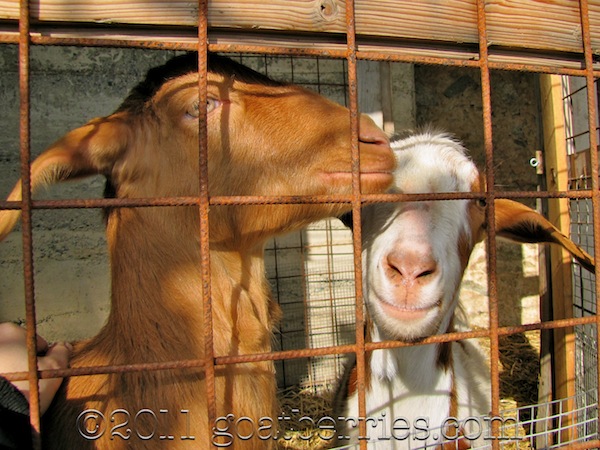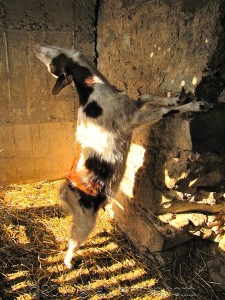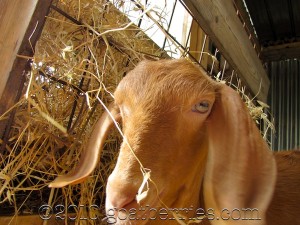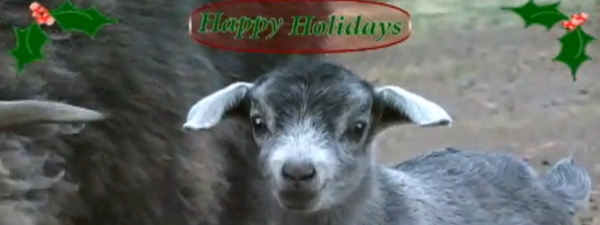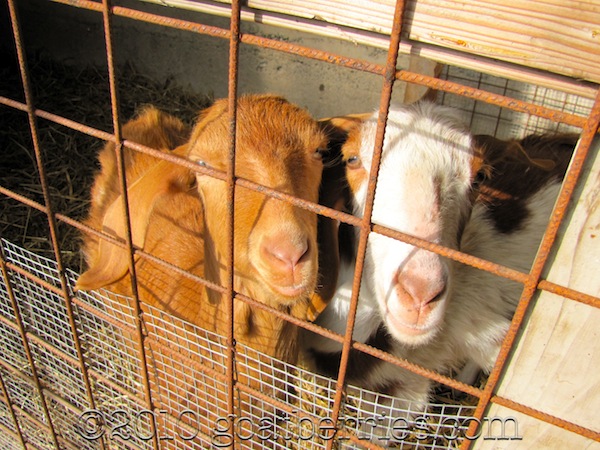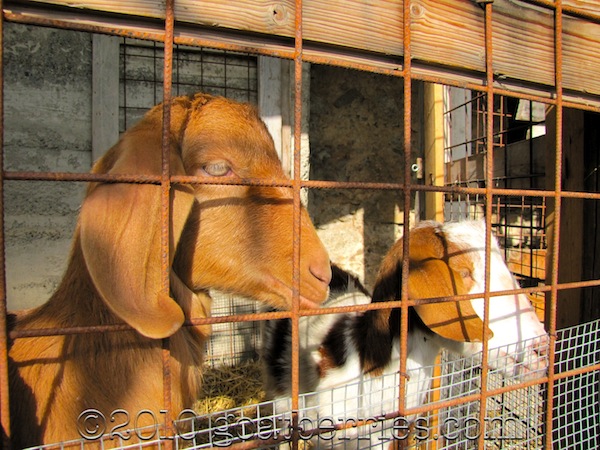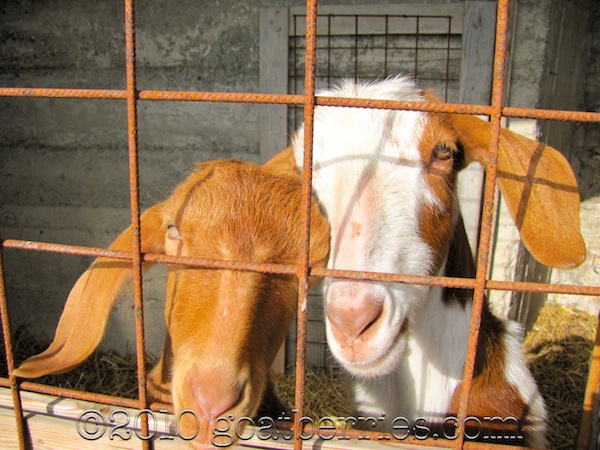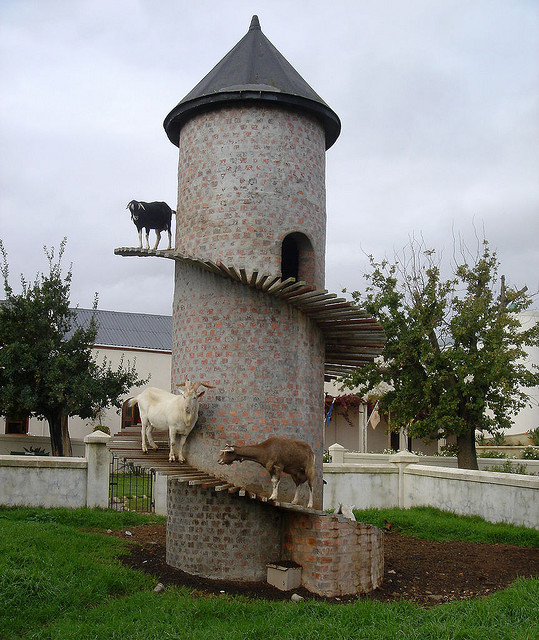Archive for the ‘Uniquely Goat’ Category
Horns or No Horns on Goats — Which is Better?
Faithful reader Renee posed a question on the Goat Berries Facebook page recently: What do we goat people feel about horns? I thought this was a great question for discussion, so I’m posting it here — please do add your thoughts on the issue as it can help other goat people make some tough decisions.
First, for anyone who doesn’t know, horns don’t go by sex; that is, you both females and males may have horns. It is a genetic trait (kind of like those adorable wattles), so if you’re breeding goats with horns, you’re probably, although not definitely, going to end up with kids with horns.
My girls are both naturally polled (born without horns), so the horn issue isn’t something we dealt with directly *but* we did aim for hornless, so I suppose you can say that I’m on the “no horn” side –beautiful as they can be. Just look at this dude:
From what I’ve read, anecdotes about how dangerous horns can be were the most persuasive to me. Goat horns can be dangerous not only for the goat caretakers and their families but also for fellow goats and other animals; goats do tend to headbutt in play and sometimes aggression and can do serious damage to others in either case.
Then there’s the possibility of the horns getting stuck in fences, etc., and putting the goat in other compromising positions, which can not only cause stress and difficulty in freeing itself (the goat can do major damage and even kill itself trying to get free), but it can also leave him or her exposed to predators — even a dog can kill a goat if it really wants to.
On the flip side, some people argue that disbudding is inhumane and unnatural as horns are goats’ natural defenses and help them cool off as sweat glands.
There’s a good discussion of this issue from a long-time goat caretaker at Fias Co. Farm, so I highly recommend heading over there for more information on this as well as on proper disbudding procedures. For the uninitiated, “disbudding” is the process of removing goat’s horns and really isn’t for the faint of heart — and quite painful for the kids too. Note that you should disbud within the first week of the kid’s life, so if you’re about to have kids, this is something you should think about sooner rather than later so you’re prepared.
For our goat-raising situation, I’d say disbudding would be best for us if faced with the horn dilemma — but this is a personal decision, of course, and I’d love to hear your take on it.
So, goat peeps, what is your position on horns? Do you goats have horns? If your goats get disbudded, do you do it yourself? Also, are your goats mixed — some polled, some horned? How does that work out?
You Know You’re a Goat Ma When…
A while ago, I did a post at Bleeding Espresso called “You Know You’re in Italy When…” and readers had a great time with it, joining in and adding their own fabulous responses. I’m hoping some more of the same will happen with this post I like to call:
You Know You’re a Goat Maaaa When…
- You can’t find a piece of clothing without some piece of hay attached.
- You always go back for just a few more face scratches.
- You don’t even notice all the goat berries that surround you.
- You can carry on a full conversation while deftly swiping away your goat’s teeth from your shirt/shorts/pants/shoelaces/jacket.
- You scour the Internet for new ways to keep your goats entertained.
- You know all your goat’s favorite songs.
- You take special care that your banana peels touch as few surfaces as possible because you know otherwise your goat won’t touch them.
- You plan your meals around what the goats would more prefer the scraps from.
- Your kids come first, period.
So, what say you? How does one know when she’s a goat maaaa?
(Or goat paaaa; we’re equal opportunity here!)
Why Is My Goat Crying and Restless?
I got a question from a reader recently asking what might be wrong with a goat that is crying and restless. Great timing, in fact, because I myself have a goat who is crying and restless — Signorina Pasqualina.
We’ll get back to her in the next post (stay tuned!), but first, and I can’t stress this enough, it is extremely important that you know your goat when trying to diagnose what the problem might be. That is, you need to know your goat’s normal behavior in order to tell if something is off — and not all goats act the same in normal circumstances, so it can be difficult to generalize. My overriding rule is that if you feel something is off, it probably is, so pay attention. But what are you looking for?
What Kind of Crying Is It?
First of all, ask yourself: what kind of cry is it? If you know your goat, you know what s/he sounds like most of the time — and you’ll definitely know the difference between normal “Hey maaaa I’m here!” bleating and any kind of pain or distress. Quick example: when Pasqualina was just a wee kid, she got herself tangled in a cord and believe-you-me, even from a pretty good distance, I knew that bleat was not just for fun and games; she was terrified (although not injured, thank goodness).
One important question to ask at this stage is whether your goat has a buddy. It doesn’t have to be another goat necessarily, but goats are social animals, and they like company. So your goat may just be crying because it’s lonely and wants some attention. But if your goat has company and suddenly starts crying for no reason, read on.
Reasons Why a Goat Might Be Crying
Once you’re pretty sure there’s something else behind the cry other than just trying to get your attention, you should look for other symptoms or behaviors that aren’t normal for your goat so you can narrow down what might be wrong with him or her. Goat bloat is where my mind always turns when I think of goat health problems, so let’s go there first.
Symptoms of Goat Bloat
Other than crying in pain, the telltale symptom of goat bloat is a larger than usual (and larger than the other side), distended left side of the goat, where the rumen is located. Goats with bloat may also show other signs of being uncomfortable like teeth grinding, kicking at their sides, and just seeming generally depressed. You should put your ear up close to the rumen and check for gurgling sounds — there should be some if the rumen is working correctly. If the bloat is more severe, a goat may also have trouble breathing.
I’ll be writing more about goat bloat and other goat illnesses in the future for handy reference, but for now, know that if you think you goat has bloat, you should first check and make sure there are no obstructions in the mouth or throat; generally you can just run your hands down the throat and feel for anything out of place. You can then start massaging his or her sides to kind of loosen up the gas that’s in there, focusing on the upper left, kind of like you’re burping a baby — your goat will hopefully start making some burps, etc. and release some gas. If some air has escaped, you can then offer some baking soda to further help balance that pH in there.
For lots more detailed information on goat bloat, visit Fias Co Farm.
There are many other illnesses a goat could have, though, so be sure to check any and all symptoms before just deciding your goat is wanting attention. Here is a handy list of potential goat illnesses along with their symptoms at from GoatWorld.
One thing we haven’t touched on, though, as a reason your doe might be crying is that she’s in heat — which is exactly what we’re going to talk about next time using our Pasqualina as a case study.
Giggle with the Goats Jingle Bells Holiday Performance
Check out this festive and OMG ADORABLE Christmas goat video from GiggleWithTheGoats.com.
Read on...A Fall Without Goat Breeding
Faithful followers of Pasqualina may remember that by this time last year, she was already pregnant with (who we now know as) Pinta.
This year Pasqualina is decidedly without kid — by our choice. And it really has more to do with Pinta than Pasqualina.
I like to call the general rule for mating a female goat as “8 and 80.” That is, when she reaches eight months old and 80 pounds, she can be safely bred.
Pinta turned eight months old toward the end of November, which technically is still heat season, but I really don’t think she was up to 80 pounds. We didn’t weigh her, so I could be wrong, but she just *seems* quite a bit smaller than Pasqualina was when we bred her (Pasqualina was around nine months old). In any event, we just feel more comfortable waiting to breed her, so that’s what we’re going to do.
We could have just bred Pasqualina, but that would have meant putting a (borrowed) buck in with Pasqualina and locking Pinta in another pen by herself to avoid any “accidents” with the buck. Yes, the pens are only separated by a see-through gate, but we figured not only would that be sad for Pinta, it would also be a little easier on us to have them both bred at the same time rather than staggered.
So the next breeding season will come early next summer, and the kids should arrive in November if, as we hope, all goes well. I’m already a little nervous about the weather being chilly for their delivery, although truth be told, daytime temps around here in November are usually still in the 70s — but there’s nothing like being a worrywart goat maaaa, right?
Anyway, for now, we just have our two girls, and they seem OK with that, don’t you think?
Do Your Goats Need a Goat Tower?
OK, *need* is a strong word, but remember when we talked about goat bridges, and how you shouldn’t show your goats that bridge if you weren’t willing to follow through?
Well check this out:
And there are lots more goat towers at Goat Towers Around the World.
Anyone else kind of jealous of those goats? How fun would it be to have your very own tower?
Imagine the amazing views!


